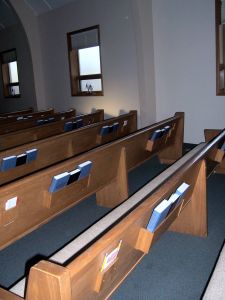Christianity—like the religion of ancient Israel—has undergone metamorphoses over the centuries. Maybe it is time for another one.
I have a friend, a recent immigrant, who is puzzled at much of what he sees in the Canadian church. In particular, he does not understand our reluctance to talk openly about the decline of churches across the country.
Are there good models of growth?
In the past year, I have been on several panels—ostensibly to discuss that very issue—only to find the moderator gently steering the discussion away from decline, and toward examples of churches that are successfully bucking the trend.
The only problem is that most of the churches held up as examples of healthy growth are growing with people who are previously churched. The good news, of course, is that these churches are catching people who might be lost to church and faith if these centres of excellence were not there to catch them.
The better news is that immigrant churches are filled and multiplying. But as a model of growth for other churches, it is limited—and masks the change that has already overtaken much of the western church and world.
If denial, despair, and celebration of non-missional growth were the only options on the menu, I would be truly depressed, but Willow Creek Community Church has pioneered another way: facing the problem. When their leadership team published the REVEAL report in 2008[i], it was a public confession that 63% of their core people were considering leaving the church, and only 7% said that the church was helping them to stay on track with their spiritual life. That kind of honesty takes courage.
The way forward
If we assume that the Gospel is not faulty, and that God has not left the building, andthat most church leaders are faithful, hardworking souls doing all that the Spirit has empowered them to do, then what is going on? Let’s start with some history.
The church almost died in infancy. Rome’s destruction of the Jerusalem Temple in AD 70 should have been catastrophic to the early church. In Acts 2, we see the apostles teaching in the Temple—a sensible strategic location of spiritual authority for Jesus’ followers and the Jewish diaspora who had also put their faith in Christ.
Some scholars see the horror of those days reflected in St. John’s Apocalypse, the Book of Revelation. It was an Apocalypse. Despite the loss of physical location and the martyrdom of almost the entire first generation of apostles, we see the regeneration of an entirely different Church, inwardly carrying the same identity and memories, but outwardly almost unrecognizable.
The shift was so complete that those who continued untransformed became known as Judaisers, simply because they wanted to retain early practices of the apostles such as circumcision, dietary restrictions, and festival days. The rest of the Church had moved on to become a multi-centred Gentile/Jewish phenomenon—while inwardly reflecting God’s original mission with fresh clarity and fruitful effect.
Apocalypse is a wonderful New Testament word, not to be confused with the modern secular meaning of doom and destruction, as in “Zombie Apocalypse”—but almost as dramatic. Apocalypse simply means revealing what is hidden in plain sight: God’s plans and purposes through cataclysmic events.
In times of discontinuous change, the formulas don’t work any more. Fortunately, we have stellar examples of how God moves faith communities through something more than change: it looks more like death followed by resurrection.
The morphing of Judaism
 One example was the destruction of Solomon’s Temple in the sixth century BC, and the exile of God’s people in Babylon for seventy years. Imagine a faith whose entire practice had revolved for centuries around burnt offerings by a clergy trained only for Temple service. Then, for more than seventy years in exile, those priests had no vocation and no location. Ordinary people of faith raised children and grandchildren who no longer spoke the language, kept the festivals, or made the necessary sacrifices. As a result, when the exiles returned from Babylon to Jerusalem, their faith in God had regenerated in a radically different form.
One example was the destruction of Solomon’s Temple in the sixth century BC, and the exile of God’s people in Babylon for seventy years. Imagine a faith whose entire practice had revolved for centuries around burnt offerings by a clergy trained only for Temple service. Then, for more than seventy years in exile, those priests had no vocation and no location. Ordinary people of faith raised children and grandchildren who no longer spoke the language, kept the festivals, or made the necessary sacrifices. As a result, when the exiles returned from Babylon to Jerusalem, their faith in God had regenerated in a radically different form.
The Temple was rebuilt eventually—but not before the portable Torah had supplanted fixed altar sacrifice as the centre of faith, and priests had given way to teachers of the law. Sabbath was practiced at the family table, led by mothers; and communities of faith sprang into being wherever ten men could make a quorum. Judaism had become portable, and less dependent on inherited priests and places.
As a result, when the Temple was destroyed a second time in 70 AD, God’s people were entirely equipped to continue without it. Fast forward 400 years to a Church that has completely adapted to the new realities of the Roman Empire. The faith has travelled Roman roads using the Roman language, building churches in Roman towns with patterns of government compatible with Roman culture. Brilliant! That is, until the Roman Empire fell, and Roman churches languished and sank into disrepair and disuse. This might have been the end, except that un-Romanized “barbarians” on the fringes of the former Empire began to build monastic communities that sent out missionaries to build new communities, and re-evangelize the world.
The Reformation was another such Apocalyptic event. Respect for the institutional church had plummeted, and faith in God was shaken by catastrophic events—climate change, plague and famine. The rediscovery of God in scripture as Christians drifted from corrupt institutions was a Godsend in every sense of the word.
Uncertainty and expectation
Like Doctor Who and his Tardis, the Church hasregenerated in another body each time—almost unrecognizable in appearance to those used to the older forms, but identical in heart and memory.
Most Canadian church leaders acknowledge that something very dramatic has happened to much of the church in Canada, but we hardly know how to talk about it, let alone undo it on a large scale—even if “undoing” were the right (or even a possible) response.
We are seeing pieces of this new regeneration, I think, in such areas as fresh expressions of church, transplanting the nucleus of a new congregation from vibrant churches into old buildings, emerging church planting movements, house churches, new monastic communities, and other places that are still in the process of morphing from one body to another.
Oswald Chambers was prescient when he said:
Naturally, we are inclined to be so mathematical and calculating that we look upon uncertainty as a bad thing. . . . [But] to be certain of God means that we are uncertain in all our ways, we do not know what a day may bring forth. This is generally said with a sigh of sadness; it should rather be an expression of breathless expectation.[ii]
Only the perspective of time will illuminate the reasons behind our era of change, but a few clear lines are already emerging from the mist. In my denominational tradition, the precipitous declines were underwritten with denial for decades. It seemed the better alternative to despair. It wasn’t. It isn’t.
Apocalypse is a bad-news word if the undead walk among us. It is a good news word for the Church of Jesus Christ risen from the dead. It is good news for a church that believes that it was founded on a rock against which the gates of hell cannot prevail. It is excellent news if we believe that the answers are hidden in plain sight.


 If you were to hang out at a Christian bookstore at the edge of many Canadian cities, you might be surprised to see who is there. Ditto if you drive past a packed church parking lot any day of the week, or a bustle of people leaving a newly planted church in an industrial area, commercial space, or home. If you overhear someone speaking openly about faith in Jesus, or offering to pray with another in a public place, there is an excellent chance that the faces you see did not grow up in western Christendom—and those voices carry the cadence of exotic locales, most originating in the Two Thirds World.
If you were to hang out at a Christian bookstore at the edge of many Canadian cities, you might be surprised to see who is there. Ditto if you drive past a packed church parking lot any day of the week, or a bustle of people leaving a newly planted church in an industrial area, commercial space, or home. If you overhear someone speaking openly about faith in Jesus, or offering to pray with another in a public place, there is an excellent chance that the faces you see did not grow up in western Christendom—and those voices carry the cadence of exotic locales, most originating in the Two Thirds World.


